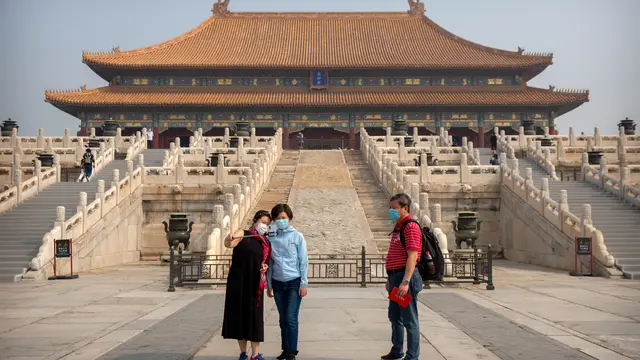
Visitors wearing face masks to protect against the new coronavirus pose for a selfie in the Forbidden City in Beijing, May 1, 2020. /AP
**Editor's note: **Iram Khan is a Pakistan-based commentator on international and commercial affairs. The article reflects the author's opinions, and not necessarily the views of CGTN.
Natural calamities upend the order of the day whenever they strike. In today's world, where transnational connectivity is entwined with our daily lives, COVID-19 has disturbed businesses, employment, and the entire financial system.
The Chinese economy also faced its share of headwind. First-quarter GDP shrank due to lockdowns, factory closures, and workplace shutdowns. Though it is important to remember here that the slump came as a result of a natural phenomenon that could have struck anywhere in any form.
Offsetting the impact of policy-induced downturns is much more difficult as their damage is generally long-term. The current losses raked up by the global as well as the Chinese economy can, however, be recuperated relatively easily with carefully defined recovery programs.
The overall strategy for economic uplift in China stays unchanged after COVID-19 since it has been tested and proven over the course of four decades. Though it continues to evolve with revised priorities, it remains focused on building the industrial and, more recently, services sectors.
To bring the growth process back to where it was before the outbreak, National Development and Reform Commission (NDRC), the premier macroeconomic management agency, has come forward with a plan to compensate for COVID-19 related losses by further opening up the economy.
Acceleration of 5G rollout, reduction of the negative list of foreign investment, adoption of a proactive fiscal policy, and facilitation of foreign companies are key highlights of the plan.
It can take anywhere between a couple of months to a full year for the development of a vaccine or a drug that can cure the disease. The revival of markets, of course, cannot wait that long.
China, therefore, adopted a containment strategy that resulted in the early recommencement of production, people's return to workplaces, and an upturn in the service sector. While the rest of the world is only considering to ease lockdowns, the average work resumption rate in China's major industrial enterprises reached 99 percent by mid-April.
The Chinese governance system has a unique characteristic wherein regulatory support to business engenders accelerated growth possibilities. During the formative period of the modern People's Republic, it allowed it to overcome the scourge of poverty and transformed the nation into a formidable economic power of the twenty-first century. The same system can put the economy back on track when the prevailing contagion subsides.

Visitors wearing face masks to protect against the new coronavirus walk through the Forbidden City in Beijing, May 1, 2020. /AP
This Chinese model takes advantage of several internal and external factors. Internally, it is fueled by a burgeoning middle class whose buying power has risen exponentially in recent years. As the country now has one of the lowest COVID-19 infection rates, the consumption level of this societal segment is returning to normal and contributing to the national economy.
Its corporate environment constitutes large enterprises that boast global footprints and smaller companies that act as a network of supportive industries. The former are capable of weathering out the ongoing setback, whereas the latter will be benefiting from cuts announced by the government in taxes, fees, costs, and rents.
Foreign firms operating in China are also optimistic about the outlook. They have disregarded the option of relocation and are retaining their supply chain strategies for the coming years. Cognizant of the resilience of the Chinese economy, they are anticipating its impending rebound.
As China has significantly overcome COVID-19, it suits multinational entities to restart the flow of profits from here. No wonder Exxon Mobil, Walmart, and others have launched ventures amounting to billions of dollars combined.
Meanwhile, externally, the Chinese economy is tied with its ability to fulfill the requirements of international consumers, companies, and markets. For this reason, China is making efforts beyond its borders to bring the pandemic under control and help other countries plug themselves back into commerce.
A comprehensive aid program is delivering protective gear and ventilators around the world. Besides that, the Chinese market is open for procurement of medical equipment by the more affluent nations. Earlier the contagion is tackled, earlier the country's exports will resume their full capacity.
Upholding globalization and multilateralism will be a challenge after COVID-19 as several governments are looking inwards and limiting international trade mechanisms. This is an incorrect way of addressing the pandemic's commercial repercussions. The solution instead lies in boosting collaboration in research while keeping overseas trade open so that the most vulnerable communities do not face extremity.
During the predicament, China's ability to provide the best products at the best price enabled such communities to stay afloat. Otherwise, the plummet in global manufacturing would have driven prices of commodities way out of reach. Thus, the Chinese affirmation of multilateralism has been vindicated in this testing time.
COVID-19 is a medical emergency. Today it is the novel coronavirus, tomorrow it can be a new microorganism in a new part of the world. China has presented a successful model of its containment and established lessons of mitigating its financial impact. As other countries surpass the infection curve, they have to take a leaf out of China's book in reopening their economies.
(If you want to contribute and have specific expertise, please contact us at [email protected].)
 简体中文
简体中文

